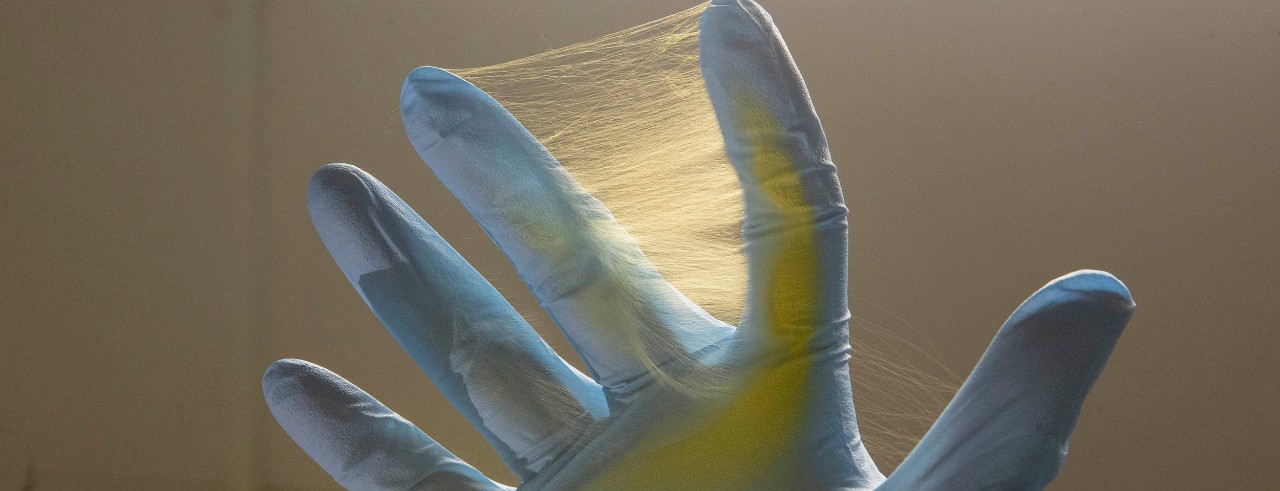
UC pioneers new brain cancer treatment
Using electrospun fibers, doctors and engineers can treat glioblastoma multiforme directly
A novel engineering process can deliver a safe and effective dose of medicine for brain tumors without exposing patients to toxic side effects from traditional chemotherapy.
University of Cincinnati professor Andrew Steckl, working with researchers from Johns Hopkins University, developed a new treatment for glioblastoma multiforme, or GBM, an aggressive form of brain cancer. Steckl’s Nanoelectronics Laboratory applied an industrial fabrication process called coaxial electrospinning to form drug-containing membranes.
The treatment is implanted directly into the part of the brain where the tumor is surgically removed.
The study was published in Nature Scientific Reports.
“Chemotherapy essentially is whole-body treatment. The treatment has to get through the blood-brain barrier, which means the whole-body dose you get must be much higher,” Steckl said. “This can be dangerous and have toxic side-effects.”

In UC's Nanoelectronics Lab, researchers use coaxial electrospinning to create fibers that contain a sheath of one material surrounding a core of another. Photo/Joseph Fuqua II/UC Creative Services
Steckl is an Ohio Eminent Scholar and professor of electrical engineering in UC’s College of Engineering and Applied Science.
Coaxial electrospinning combines two or more materials into a fine fiber composed of a core of one material surrounded by a sheath of another. This fabrication process allows researchers to take advantage of the unique properties of each material to deliver a potent dose of medicine immediately or over time.
“By selecting the base materials of the fiber and the thickness of the sheath, we can control the rate at which these drugs are released,” Steckl said.
The electrospun fibers can rapidly release one drug for short-term treatment such as pain relief or antibiotics while an additional drug or drugs such as chemotherapy is released over a longer period, he said.
“We can produce a very sophisticated drug-release profile,” Steckl said.

UC research associate Daewoo Han works in UC's Nanoelectronics Laboratory. He is lead author of a new study on glioblastoma. Photo/Joseph Fuqua II/UC Creative Services
The breakthrough is a continuation of work conducted by research partners and co-authors Dr. Henry Brem and Betty Tyler at Johns Hopkins University, who in 2003 developed a locally administered wafer treatment for brain tumors called Gliadel.
Unlike previous treatments, electrospun fibers provide a more uniform dose over time, said UC research associate Daewoo Han, the study’s lead author.
“For the current treatment, most drugs release within a week, but our discs presented the release for up to 150 days,” he said.
Glioblastoma multiforme is a common and extremely aggressive brain cancer and is responsible for more than half of all primary brain tumors, according to the American Cancer Society. Each year more than 240,000 people around the world die from brain cancer.
This represents a promising evolution for the current treatment of GBM.
Daewoo Han, UC research associate
The electrospun fiber created for the study provided a tablet-like disk that increased the amount of medicine that could be applied, lowered the initial burst release and enhanced the sustainability of the drug release over time, the study found.
Chemotherapy using electrospun fiber improved survival rates in three separate animal trials that examined safety, toxicity, membrane degradation and efficacy.
“This represents a promising evolution for the current treatment of GBM,” the study concluded.
While this study used a single drug, researchers noted that one advantage of electrospinning is the ability to dispense multiple drugs sequentially over a long-term release. The latest cancer treatments rely on a multiple-drug approach to prevent drug resistance and improve efficacy.
Steckl said the study holds promise for treatments of other types of cancer.
“Looking ahead, we are planning to investigate ‘cocktail’ therapy where multiple drugs for the combined treatment of difficult cancers are incorporated and released either simultaneously or sequentially from our fiber membranes,” Steckl said.
Featured image at top: UC applied coaxial electrospinning to create a new treatment for brain tumors. Photo/Joseph Fuqua II/UC Creative Services

UC engineering professor Andrew Steckl is developing new medical applications for coaxial electrospinning in his Nanoelectronics Laboratory. Photo/Joseph Fuqua II/UC Creative Services
Next Lives Here
The University of Cincinnati is classified as a Research 1 institution by the Carnegie Commission and is ranked in the National Science Foundation's Top-35 public research universities. UC's graduate students and faculty investigate problems and innovate solutions with real-world impact. Next Lives Here.
Become a Bearcat
- Apply online or get more information about undergraduate enrollment by calling 513-556-1100.
- Learn more about UC's many undergraduate and graduate programs.
Related Stories
First-ever Gen-Z Insights event hosted by UC NEXT Innovation...
April 19, 2024
In academia, the intersection of innovation, collaboration and the fresh perspectives of the University of Cincinnati NEXT Innovation Scholars (NIS) holds immense promise. As a multi-disciplinary student group of innovators, the program balances university, corporate and non-profit partners. NIS students are driven by curiosity, passion, future creation and pursuing innovation, fostering a community of forward-thinkers poised to tackle tomorrow's challenges today. Recently, these young visionaries hosted an inaugural Gen-Z Insights showcase event at the UC 1819 Innovation Hub. The packed room of attendees included 1819 corporate partners such as Kao and Main Street Ventures and distinguished faculty and staff members. All were eager to hear and learn more from NIS scholars and the industry projects they worked on throughout the year.
UC's CECH recognizes students, faculty and staff for outstanding...
April 19, 2024
In the early weeks of April 2024, UC's College of Education, Criminal Justice, Human Services, and Information Technology recognized and celebrated students, faculty and staff achievements annual Outstanding Student Awards and All College Awards ceremony, the latter of which awarded both Faculty and Staff Awards and the college's Golden Apple Awards.
WVXU: Test your word puzzle skills with a Cincinnati...
April 18, 2024
Cincinnati edition host Lucy May discusses the history and new found popularity of word games with Michael Griffith, professor English. Griffith is a writer, but also develops word games for publication.
